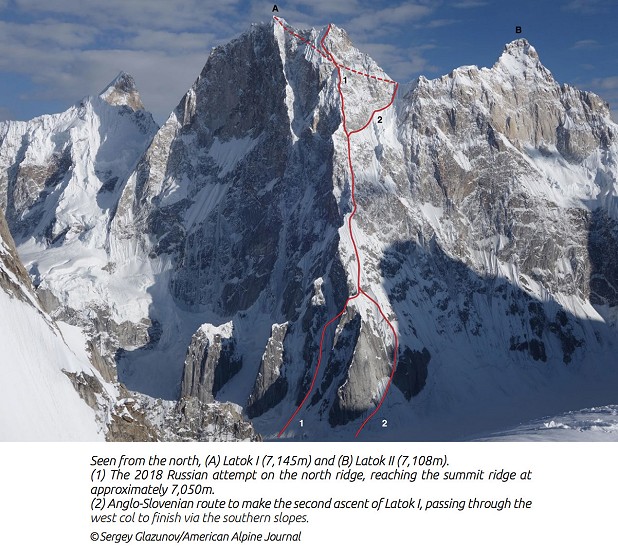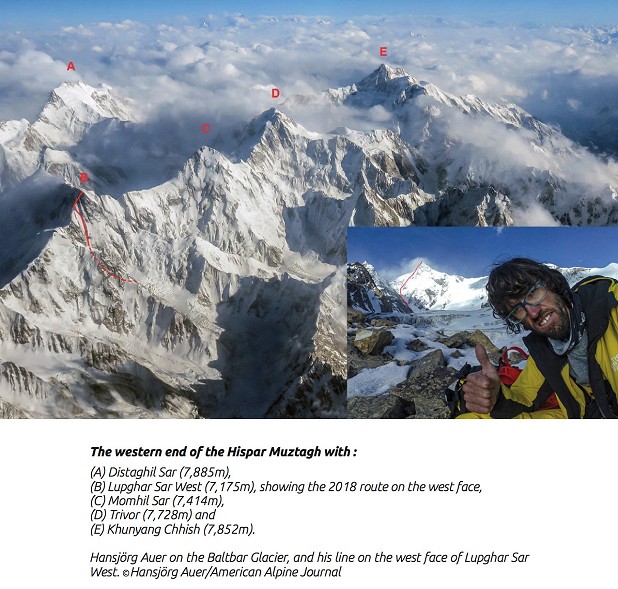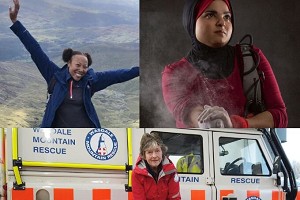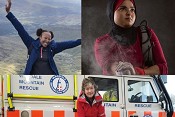
The winners of the prestigious Piolets d'Or 2019 have been announced. Each year, the Piolets d'Or recognise significant new ascents in mountaineering; taking style, innovation, commitment and respect for both the environment and local people into consideration. In 2019, three awards will be presented at the Ladek Mountain Festival in Poland in September: two are posthumous and one will be awarded to British mountaineer Tom Livingstone and his Latok I team.

One team ascent and two solo ascents were recognised: Aleš Česen, Luka Stražar (SLO) and Tom Livingstone (GBR) for their first ascent of Latok I (7,145m) from the North, via the North Ridge/Face and South Face; David Lama's (AUT) first and solo ascent of Lunag Ri (6,895m) via the West Ridge and Hansjörg Auer's solo ascent of Lupghar Sar West (7,157m) via the West Face.
The families of David Lama and Hansjörg Auer, who were killed in an avalanche on Howse Peak in April this year along with US mountaineer Jess Roskelley (UKC news), will accept the awards in their honour.
The 2019 Lifetime Achievement Award (Piolet d'Or Carrière) will be awarded to Polish mountaineer Krzysztof Wielicki, one of the foremost mountaineers from the Golden Age of Polish Himalayan climbing, whose 1996 solo ascent of the Kinshofer Route on Nanga Parbat is considered to be the most demanding of his achievements. Read his mountaineering biography here.
Below are the descriptions of the award-winning ascents and the reflections and considerations made by the Piolets d'Or Jury.
Latok I (7,145m) North Ridge/Face and South Face
2,500M, ED+, ALEŠ ČESEN - LUKA STRAŽAR (SLOVENIA) - TOM LIVINGSTONE (U.K.), AUGUST 5–9
The North Ridge of Latok I was described by US alpinist Jeff Lowe - part of the first team to attempt the line in 1978 alongside Jim Donini, Michael Kennedy and George Lowe - in the Alpinist essay 'Unclimbed' as 'the unfinished business of the last generation.' This "Walker Spur of the Karakoram" subsequently attracted dozens of attempts by international teams, who failed to reach their highpoint at nearly 7,000m.
Tom Livingstone, Luka Stražar and Aleš Česen travelled to the north side of Latok I in 2018, where Cešen confided: 'We think there is a better way to the summit than the full north ridge.' American Josh Wharton, who travelled to the Choktoi Glacier four times to attempt the north ridge, envisaged a line that would climb the right flank of the ridge, then slant up to the (west) col between Latok I and II. From there his proposed route crossed onto the south side of the mountain, where easier terrain would lead to the top. This line was adopted by the trio, who climbed generally good ice runnels and névé on the right side of the ridge to around 6,400m, at which point they angled up right to reach the west col at 6,700m. From there they followed south-facing snow slopes in generally stormy weather to the summit, which they reached on their fifth day. Descending approximately the same line, the team regained base camp three days later, having made only the second ascent of this prestigious mountain in the Panmah Muztagh, and the first from the north.
Lunag Ri (6,895m) via the West Ridge
1,500M, 90°, DAVID LAMA (AUSTRIA), SOLO, OCTOBER 23-25
Lunag Ri is the culminating point of the Rolwaling's Lunag Massif, which straddles the Nepal-Tibet border. Before 2018 it was one of the highest unclimbed peaks in Nepal and there had been at least four serious attempts to reach its lofty summit. An attempt from the southeast, and another from the north, both finished on a subsidiary southeast top. In 2015 Conrad Anker and David Lama reached a point on the west ridge around 300m below the summit, finding the ridge more complex and difficult than expected. They returned in 2016, only for Anker to be evacuated by helicopter after suffering a stroke. Lama subsequently made a bold solo attempt, surpassing his previous high point by around 50m. In 2018, when Anker confirmed he would no longer go on this sort of expedition, Lama decided to decline other offers from strong partners and to go it alone. In the intense cold of late October, the Austrian climbed difficult mixed terrain, ice and snow, with two bivouacs, to reach the crux technical climbing on the steep headwall. Surmounting this, he made an airy traverse on to the spectacular diving-board summit. Lama descended by rappel, mostly along the line of his route. It was a climb that would remain "engraved in [his] memory for the exposure, the difficulty, the cold and the loneliness, and for a successful conclusion to a personal project."
Lupghar Sar West (7,157m) via the West Face
1,000M, M4 55°, HANSJÖRG AUER (AUSTRIA), SOLO - IN A DAY, JULY 7
The rarely-attempted Lupghar Sar massif in the Hispar Muztagh of the Western Karakoram comprises three peaks on a high east-west summit ridge. The west summit was first climbed in 1979 by Germans via the southwest ridge, which featured dangerously rotten rock - a characteristic of this summit. It was repeated the same year, and again in 1980, by Japanese, the first of these expeditions continuing east for more than one and a half kilometres along the sharp ridge to the Central (Main) summit. These were full scale sieges and neither the West or Central peaks were seriously attempted again until 2018. After extensive acclimatisation and scouting of both face and complex approach, Hansjörg Auer left base camp and navigated the wild Baltbar Glacier to a bivouac at 6,200m below the left side of the west face of Lupghar Sar West. The next day he made a rapid ascent of the west face to reach the steep upper section of the northwest ridge at 6,900m. Although he had planned a second bivouac, he decided to cache his gear and head for the top. Very loose mixed terrain and a highly exposed, narrow, corniced crest led to the highest point. Auer managed to descend to base camp by the evening of the same day. Although the technicalities were not high, this was bold, committing and precarious climbing, with a taxing descent of the same route, completely alone at high altitude and in a remarkably fast time.
List of Significant Ascents in 2018, recognised by the Jury:
(British teams/teams including a British climber highlighted in bold)
ASIA
India
Kishtwar Himalaya, Cerro Kishtwar (6,173m)
Genki Narumi - Yusuki Sato - Hiroki Yamamoto (Japan)
Kinnaur, Baspa Valley, Peak (6,050m)
Hansjorg Auer - Max Berger - Much Mayr - Guido Unterwurzacher (Austria)
Gangotri, Janhukot (6,805m)
Malcolm Bass - Guy Buckingham - Paul Figg (UK)
Garhwal, Changabang (6,864m)
Leo Billon - Sébastien Moatti - Sébastien Ratel (France)
Pakistan
Kachqiant (6,015m)
Danny Schoch-Bas Visscher (the Netherlands)
Nanga Parbat (8,125m)
Tomasz Mackiewicz (Poland) - Elisabeth Revol (France)
Luphgar Sar West (7,157m)
Hansjorg Auer (Austria)
Latok I (7,145m)
Ales Cesen - Luka Strazar (Slovenia) - Tom Livingstone (UK)
Latok I (7,145m)
Sergey Glazunov-Alexander Gukov (Russia)
Suma Brakk (6,166m)
Fabian Buhl-Alex Huber (Germany)
Hainabrakk East Tower (5,650m)
Pete Fasoldt - Jonathan Schaffer (USA)
Gasherbrum II (8,034m)
Felix Berg (Germany) - Adam Bielecki (Poland)
Changi II (6,250m)
Nelson Neirinck (Belgium) - Jess Roskelley - Kurt Ross (USA)
Nepal
Himjung (7,092m)
Vitus Auer-Sebastien Fuchs-Stefan Larcher (Austria)
Langdung (6,386m)
Jesus Ibarz-Edu Recio-Pablo Ruiz (Spain)
Drangnag Ri (6,757m)
Iñaki Arakistain-Alberto Fernández-Joseba Larrañaga-Mikel Zabalza (Spain)
Lunag Ri (6,895m)
David Lama (Austria)
Kyajo Ri (6,151m)
Zdenek Hak-Marek Holecek (Czech Republic)
Pumori (7,161m)
Romeo Popa-Zsolt Torok-Teofil Vlad (Romania)
Sharphu II (6,328m)
Spencer Gray-Aivaras Sajus (USA)
China
Daxue Shan, Minya Konka (7,556m)
Li Zongli-Xiao Hai (China)
Kyrgyzstan
Western Kokshaal-too, Kyzyl Asker (5,842m)
Evgeny Murin-Ilya Penyaev (Russia)
Djangart Range, Pik Alexander (5,290m)
Line van den Berg-Wout Martens (Netherlands)
Georgia
Shkhara (5,203m)
Archil Badriashvili - Giorgi Tepnadze (Georgia)
Tajikistan
Korzhenevskaya (7,105m)
Roman Abildaev - Alexey Usatykh (both Russian) - Semen Dvornichenko - Sergey Seliverstov (both Kyrgyzstan)
NORTH AMERICA
Montana
Cabinet Mountains, A Peak (2,632m)
Scott Coldiron-Jess Roskelley (USA)
Alaska
Revelation Mountains, Mt Jezebel northeast summit (2,880m)
Uisdean Hawthorn - Tom Livingstone (UK)
Revelation Mountains, Hydra Peak (2,380m)
Thomas Auvaro-Jeremy Fino - Antoine Rolle (France)
West Kahiltna Peak (3,912m)
Nik Mirhashemi - Kurt Ross (USA)
Mendenhall Tower, Main tower (2,106m)
Marc André Leclerc (Canada)-Ryan Johnson (USA)
Devil's Paw (2,616m)
Brette Harrington-Gabe Hayden (USA)
Canada
Selkirk Mountains, Mt MacDonald (2,883m)
Chris Wright-Graham Zimmerman (USA)
Rockies, Mt Temple (3,547m)
Alik Berg (Canada)
Rockies, Mt Slesse (2,439m)
Marc Andre Leclerc (Canada) - Tom Livingstone (UK)
Rockies, Mt Blane (2,993m)
Brette Harrington (USA) - Rose Pearson (NZ)
SOUTH AMERICA
Argentina-Chile
Torres del Paine, Cerro Almirante Nieto (2,440m)
Felipe Bishara-Christian Barra Munoz (Chile)
Southern Patagonia, Cerro Riso Patron Sur (2,350m)
Matteo della Bordella (Italy) - Silvan Schupbach (Switzerland)
Cerro San Lorenzo, south pillar (El Faro, 3,150m)
Martin Elias (Spain) - Francois Poncet - Jerome Sullivan (both France)
Northern Patagonia, Punta Pantagruel (2,410m)
Felipe Cancino (Chile)-Max Fisher (Canada)-Willy Oppenheim (USA)
Bolivia
Sajama (6,542m)
Robert Rauch (Bolivia/Germany)
Mururata (5,871m)
Ethan Berman-Brian Houle (USA)
Peru
Cordillera Vilcanota, Campa II (ca 5,650m)
Luis Crispin-Macario Crispin (Peru)-Duncan McDaniel (USA)
Cordillera Huayhuash, Jurau A (5,640m)
Jose Maria Andres-Samuel Gomez (Spain)
Cordillera Blanca, Nevado Huantsan (6,395m)
Devin Corboy (USA) - Macario Crispin (Peru) - Nathan Heald (USA) - Arttu Pylkkanen (Finland) - Javier Reyes (Chile) - Johannes Suikkanen (Finland)
AUSTRALASIA
New Zealand
Darran Mountains, Mt Suter (2,094m)
Ben Dare (NZ)
Southern Alps, Mt Percy Smith (2,465m)
Ben Dare (NZ)
Southern Alps, Mt Cook (3,764m)
Caleb Jennings-Kim Ladiges (NZ)
Southern Alps, Mt Cook (3,764m)
Rose Pearson-Sam Waetford (NZ)
ANTARCTICA
Pirrit Hills, Mount Tidd (2,244m)
Antoine Bletton - Sébastien Moatti (France)
EUROPE
Norway
Senja, Breitinden (1,001m)
Greg Boswell (UK) - Jeff Mercier (France)
Lofoten, Stortinden (866m)
Sami Modenius (Finland) - Chris Wright (USA)
Gudvangen Region, The Kraken
Phillipe Batoux - Aymeric Clouet - Michel Coranotte (France)
Alps
Mont Blanc (4,808m), Miage (northwest) face
Simon Richardson (UK)-Micha Rinn (Germany)
Grandes Jorasses (4,208m), east face
Max Bonniot-Pierre Labbre-Manu Romain (France)
Gross Grunhorn (4,044m)
Dani Arnold - Stephen Ruoss (Switzerland)
Cima Brenta, east face (3,150m)
Alessandro Beber - Mateo Faletti (Italy)
Watzmann (2,713m)
Luka Lindic (Slovenia) - Ines Papert (Germany)
Sagwand (3,227m)
David Lama - Peter Muhlburger (Austria)
***
Other notable ascents during 2018 that do not quite fit the strict criteria:
South America, South Avellano Tower (ca 1,900m)
John Crook-John McCune-Will Sim-Paul Swail (UK)
Greenland, Fox Jaw Cirque, Molar
Robert Jasper (Germany)
Dolomites, Cima Scotoni (2,874m)
Simon Gietl (Italy)
Dolomites, Cima Scotoni (2,874m)
Nicola Tondini, with Lorenzo d'Addario (Italy)
Pakistan, Kiris Peak (5,428m)
Massimo Faletti-Maurizio Giordani (Italy)
Pakistan, Pathan Peak (ca 6,000m)
Nicolas Favresse (Belgium)-Mathieu Maynadier (France)-Carlitos Molina (Argentina)-Jean-Louis Wertz (Belgium)
Greenland, Mythics Cirque, Ataatap Tower (ca 1,350m)
Philippe Batoux-Lionel Daudet-Patrick Wagnon (France)
















Comments
Mont Blanc (4,808m), Miage (northwest) face Simon Richardson (UK)-Micha Rinn (Germany)
Should this his not be highlighted in bold
I find it comforting that a brief annual report on the most cutting edge climbing, the climbing that defines the risk taking, adventure that so drew me in, many years ago, gets so little interest and comment on a climbing forum. I like the fact it is of less interest than 'Chalk bag for big hands' or 'Average Speed Cameras' or 'Is Boris a total or Partial Loon?'.
It tells me that the real heart of the pastime is as crazy and esoteric and of little interest to the average punter as ever. Excellent!
Pretty exceptional year for Tom Livingstone when he wins a Piolet d'Or and has a further two ascents on the longlist.
My utmost congratulations to all the winners and the other notable ascents but there's something quite bitter in the list of its 3 winners given that two of the awards are being awarded posthumously and the third is being awarded to a team for a route a stones throw away from the the one that killed Sergey Glazunov.
It's been a cruel year for mountaineering and I feels like Piolet D'or has unconsciously acknowledged that.
Thanks all.
I know it's a bit lame, but I wanted to give my thoughts on the PdO. (UKC - you can delete this comment and include it in the original article if you want)
It’s nice for people to acknowledge the years of effort and dedication associated with Aleš, Luka and my ascent of Latok I last year, but I don’t agree with the concept of awards in alpine climbing. To award a trophy is to signify that something is the best, implying others are not as worthy. Alpine climbing is a subjective activity; it’s artistic, serious, and there are no winners or losers.
An example is the UK Young Alpinists Meet, an event taking place right now that I’ve organised. Should I award the ‘best climb?’ What is the ‘best?’ There are those that recognised their limitations and asked for help, or chose to turn back on routes; they made sensible mountaineering decisions. But what about those that pushed themselves to get to the summit, but maybe took more risks?
Some view the PdO as the ‘Oscars of Climbing,’ but it has a poor history. It provoked competitiveness, played on climber’s egos, and awarded very controversial ‘alpine style’ attempts (sometimes not even alpine style). It now seems to be more of a celebration of climbing and meeting of friends, which I like... but why still the awards?
I respect these climbers who have previously been ‘involved’ with the PdO: Marko Prezelj, Rolo Garibotti and Ian Parnell. Part of me wishes to follow in their style and actions… and part of me just wants to go climbing. You should read their comments about the PdO.
To quote Marko Prezelj, but to use my own trips from last year: ‘I climbed in Canada, Scotland, Slovenia, Alaska, UK, Pakistan, India and America. I cannot decide which trip was the most... the "most what" in fact?’
I also do not appreciate how the PdO makes me feel. It plays on my human ego. I already have a devil on my shoulder at the end of a run-out who whispers, ‘uh oh, you’re gonna take a big one!’ I don’t want another offering me a golden trophy. And I’m being partly hypocritical - I am a sponsored climber (I wouldn’t say ‘professional athlete,’ but perhaps that’s because I’m British). I play the game, and I post about it online. But I have drawn my line of comfort in the sand, and I rarely cross it.
I respect the views of others - I guess some may value this award. And I would like to offer my condolences to the families of David Lama and Hansjorg Auer. They were inspiring people and climbers. But I also want to remember Marc-Andre Leclerc, Jess Rosskelley, Tom Ballard, and many others.
If you really want to say ‘nice one,’ then I would humbly accept your comment. But a more appropriate word would be ‘jebise,’ which is Slovenian humour, and a greeting between good friends. It’s said with a smile. It means, ‘hey, f*ck you!’
The Pakistan trip was Luka and Aleš’s idea, and we shared an unexplainable, unquantifiable adventure in the mountains. Our trip to Pakistan will forever be burned into my memory. I am grateful to call them good friends.
I will not be at the PdO this year, which is fine by me - I’ll be in Pakistan with good friends, hopefully climbing in the mountains. Since Aleš and Luka are apathetic about the award, they will attend the PdO, and will accept their (second) trophy. I will follow their example and also accept. But my heart and my head say: this is not for me. I am very tempted to say ‘f*ck you!’ to the award. But whatever, I’m going climbing.